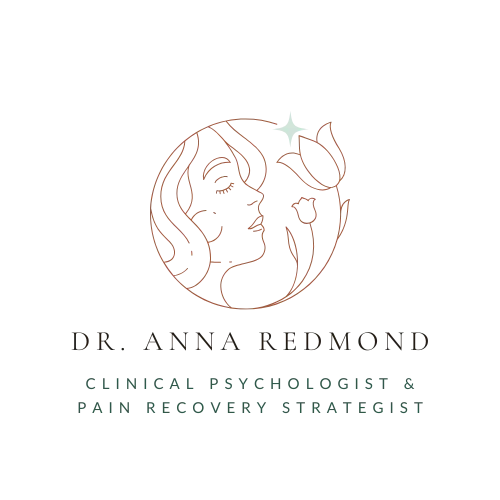Connect with me!
Tell me the number one thing that you want to understand about your pain?

When Pain Takes Control: 6 Phases in the Cycle of Chronic Pain
Education provides the power to take the next step in managing your pain. You want to do the things you enjoy (or even basic daily activities) without flaring up your pain. For a limited time, you can grab my free video tutorial to get you started:
3 Simple Steps to a Balanced Day... Without the Flare-Ups.
This free video tutorial is dedicated to helping women with pain begin to find confidence to return to the moments, activities, and people they love the most.Fear is a normal byproduct of the brain, but it is also a main character in the cycle of chronic pain, and can keep your pain going... for years.
Your brain starts misinterpreting signals from the body as dangerous. Fear around pain reinforces for your brain the idea that pain is actually dangerous. It keeps the cycle going.
Over and over.
Your brain learns, from practice, to create pain chronically. This cycle is so common and so easy to fall into.
Here are 6 phases in the cycle of chronic pain (and where to break free):
Phase 1: Lasting pain
When pain has persisted longer than 6 months, changes in the nervous system are contributing to your overall pain experience. Emotions, thoughts, coping behaviors, language/education used by your providers, and environment are contributing to your pain. Regardless of diagnosis. Regardless of whether your condition is "curable". Regardless of what you've tried in the past.
Phase 2: You worry pain means damage/harm
“When something hurts, is it bad for me"? When we think hurt means harm, research shows that we experience higher pain intensity regardless of whether actual damage is occurring. In addition, any suggestion that we may be in danger of harming ourselves will cause the brain to produce pain order to draw our attention to that situation and protect us. How do we usually protect ourselves? By avoiding.
Phase 3: Avoiding activities
You avoid activities because they hurt! Fear is a very normal reaction to any perceived threat, such as pain or injury. Fear prompts the fight or flight response but also defensive behavior. One defensive behavior triggered is avoidance of activities that you associated with the occurrence or worsening of pain.
Avoidance of activities is adaptive in the acute phase of pain (months 0-6 when most of the healing takes place) to avoid further injury. Continued avoidance during the chronic phase (after month 6 ), however, can lead to distress, disability, absenteeism, and increased healthcare costs. In addition, weakened muscles cause normal activities to become more painful.
Phase 4: Negative thoughts
Negative thoughts start to creep in, resulting in negative emotions. Pain is taking up more space in your mind. Negative thoughts about pain, its consequences (often worst-case scenario thinking) can result in pain-related fear, avoidance of daily activities, and hypervigilance about the body and movement. Education followed by intentional confrontation of activities, on the other hand, has the opposite effect and leads to the reduction of fear over time.
Three types of negative thoughts to look for:
Magnification: Worst-case scenario thinking about the power of your pain, how much worse it will get, how long it will last.
Rumination: Constantly thinking about your pain, it becomes a distraction, difficult to stop thinking about how much it hurts.
Helplessness: Thinking everything you do is futile, losing hope that you can overcome your pain.
Phase 5: Avoidance and withdrawal
You find yourself avoiding and withdrawing further. We think that we can avoid our pain or a flare-up by majorly reducing our movement, the positions we put ourselves in, the small rotations of our body, the activities we do, and the people we see. We think we can avoid pain by making our lives smaller. Instead, we see increased fear, more protection from the brain, and more sensitivity. We see more activities causing pain when we avoid.
Phase 6: Nervous system sensitivity and distress
One of the very normal jobs of everyone's brain and nervous system is to monitor for threats constantly. Its purpose is to protect us. When there is a threat, the alarm is activated, it sends a message to the brain, and we take care of the problem. When threat goes away, alarm goes down. But as we know, there are so many contributors to our experience that can keep us on high alert - avoidance, negative thoughts, negative emotions, isolation, fear. The alarm to alert us to pain becomes faulty, our brain becomes overprotective, and more practiced at creating pain.
What happens next?
More chronic pain... The loop starts again and this time, your nervous system is more sensitive.
5 signs of a sensitized nervous system:
Persistent, constant, unremitting pain
Pain has become more widespread and easily provoked
The list of failed medical or therapeutic interventions is getting longer
Worst-case scenario thinking, distress, and avoidance
Low sense of ability to cope as well as negative emotions, unhelpful thoughts
It is so common to feel like your life is shrinking because of pain.
I’m here to tell you that you can EXPAND and design a life that is bigger than pain.
Education provides the power to take the next step in managing your pain. You want to do the things you enjoy (or even basic daily activities) without flaring up your pain. For a limited time, you can grab my free video tutorial to get you started:
3 Simple Steps to a Balanced Day... Without the Flare-Ups.
This free video tutorial is dedicated to helping women with pain begin to find confidence to return to the moments, activities, and people they love the most.
BACK PAINCAN MENOPAUSE CAUSE PAINCHRONIC PAINCHRONIC PAIN CYCLECHRONIC PAIN DEFINITIONCHRONIC PAIN HELPCHRONIC PAIN JOINTSCHRONIC PAIN MANAGEMENTCHRONIC PAIN NECK AND BACKCHRONIC
© 2024 | Anna Redmond, LLC | drannaredmond.com
